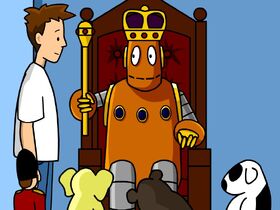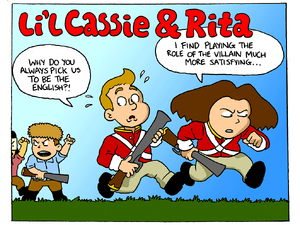| Causes of the American Revolution | |||
|---|---|---|---|
 | |||
| Airdate | October 21, 2003 | ||
| Curriculum | Social Studies | ||
Causes of the American Revolution launched in BrainPOP Social Studies October 21, 2003.
Summary
Moby is playing king. Moby burns the teddy bear using hand fire. Tim walks in to see Moby had burned the teddy bear.
Appearances
Transcript
Quiz
FYI
Famous Faces

One of the fiercest backers of American independence was Thomas Paine. In 1774, when he was 37 years old, the English-born Paine met Benjamin Franklin in London. The two struck up a friendship, and Paine wound up moving to Philadelphia within a year.
On January 10, 1776, Paine published a pamphlet called Common Sense, which laid out an argument for independence from Britain. Common Sense became a bestseller, and it convinced a lot of people that independence was a goal worth achieving.
At the time, the issue of independence was extremely controversial. But Paine had a gift for making complicated arguments in simple, direct language that people could understand and relate to. For instance, the idea that “all men are created equal,” made famous by the Declaration of Independence, appeared first in Common Sense.
Paine also railed against the “tyranny” of King George III; dismissed the idea of a hereditary monarchy as old-fashioned and unfair; and urged the colonists to take up arms against the British. He even proposed the name “United States of America” for the new country!
During the war, Paine wrote a series of anti-British pamphlets known collectively as “The Crisis Papers” or “The American Crisis.” George Washington found Paine’s words so inspiring that he ordered them to be read aloud to his men!
After the war, Paine became a fervent supporter of the French Revolution, and he almost wound up being executed during that struggle’s Reign of Terror. He died in New York City in 1809.
Way Back When

One of the earliest conflicts between Great Britain and the colonies was called the Parson’s Cause. Here’s the story.
In 1758, there was a drought in Virginia. This hurt the growth of tobacco, the state’s chief crop, the price of which price shot up from 2 cents a pound to around 6 cents a pound.
Back then, tobacco was used as currency. In fact, it was used by the State of Virginia to pay the salaries of its Anglican ministers. But the drought made it difficult for farmers to pay their taxes to the state in tobacco, creating a financial crunch.
So the state legislature enacted a measure called the Two Penny Act. It said that all tobacco debts could be paid off in paper money, at the price of 2 cents per pound
Some ministers got upset, and argued that they should receive market value for the tobacco: 6 cents per pound, not 2. They took their case all the way to the King of England, who agreed with them and overturned the Two Penny Act.
To receive his back wages, Virginia reverend James Maury sued the state in court. A young lawyer named Patrick Henry (pictured, with arm raised) represented the state and argued that the king had no right to overturn a law passed by the Virginia legislature—and that by doing so, he became a tyrant.
The court agreed with Henry and awarded only one penny in damages to Maury. This effectively overruled the King’s veto . . . and provided a glimpse of the conflicts to come.
Personalities

Pity King George III of Great Britain. To American students, he’s the tyrant whose taxes and oppression led to the Revolutionary War. To British students, he’s the crazy guy who lost the colonies. But many historians actually see him as a victim of circumstances that were mostly beyond his control.
First, there’s the matter of the Intolerable Acts, the Stamp Act, and all the other Acts that brought the colonists to the brink of revolt. These acts weren’t random exercises of King George’s royal power. Instead, they were the British government’s attempts to stay out of financial ruin.
The French and Indian War, fought from 1756 to 1763, had put a major dent in the royal bank account. The British Parliament proposed, and King George agreed, that the colonists should pay their fair share of the debt. After all, the war had been waged for their benefit, and they were barely paying taxes at all compared to the average Englishman, who paid 50 times more in taxes than the average American!
George was insulted by the charges against him in the Declaration of Independence, and he wanted to prolong the war as long as possible to punish the colonists for their behavior. Although he didn’t want to admit defeat in the American Revolution, he eventually accepted it with dignity, telling John Adams, “I was the last to consent to the separation; but I would be the first to meet the friendship of the United States as an independent power.”
Etc.

If you’ve ever been to Philadelphia, you’ve probably noticed that the image of the Liberty Bell is everywhere—they even ring a 15-meter-high neon liberty bell at Citizens Bank Park every time a Phillies player hits a home run. So naturally, a lot of people wonder what is so important about that bell.
The Liberty Bell was ordered by the Pennsylvania state legislature in 1753 to commemorate the 50th anniversary of the Pennsylvania colonial constitution, which was known as the Charter of Liberties. That’s why the bell has an inscription on it reading, “Proclaim LIBERTY throughout all the land unto the inhabitants thereof.”
The bell was hung in the Pennsylvania state house. Now known as Independence Hall, it’s the building where the Declaration of Independence was debated and adopted.
According to legend, the bell was allegedly rung on July 8, 1776 to summon the citizens of Philadelphia to hear a reading of the Declaration. But this might be just a story, since the steeple where the bell was supposed to be hung was in bad shape by 1776.
Known as the “Independence Bell” until the 1830’s, it was first called the “Liberty Bell” in an abolitionist pamphlet; after that, it became a symbol of the anti-slavery movement.
Incidentally, the crack appeared the very first time the bell was rung, in March of 1754. The reason? Good old-fashioned shoddy workmanship.
FYI Comic

Newslea
https://newsela.com/read/smi-american-revolution-liberty-tree/id/20313/
